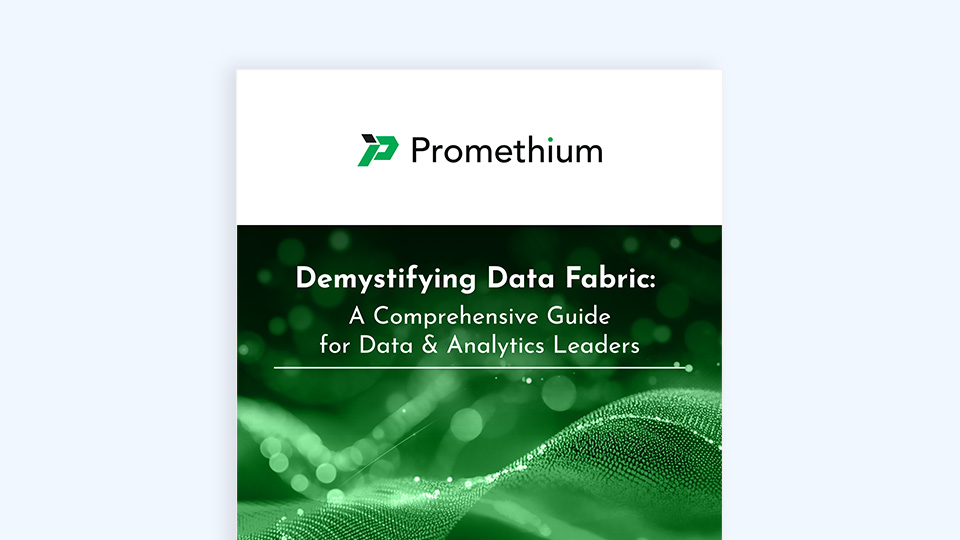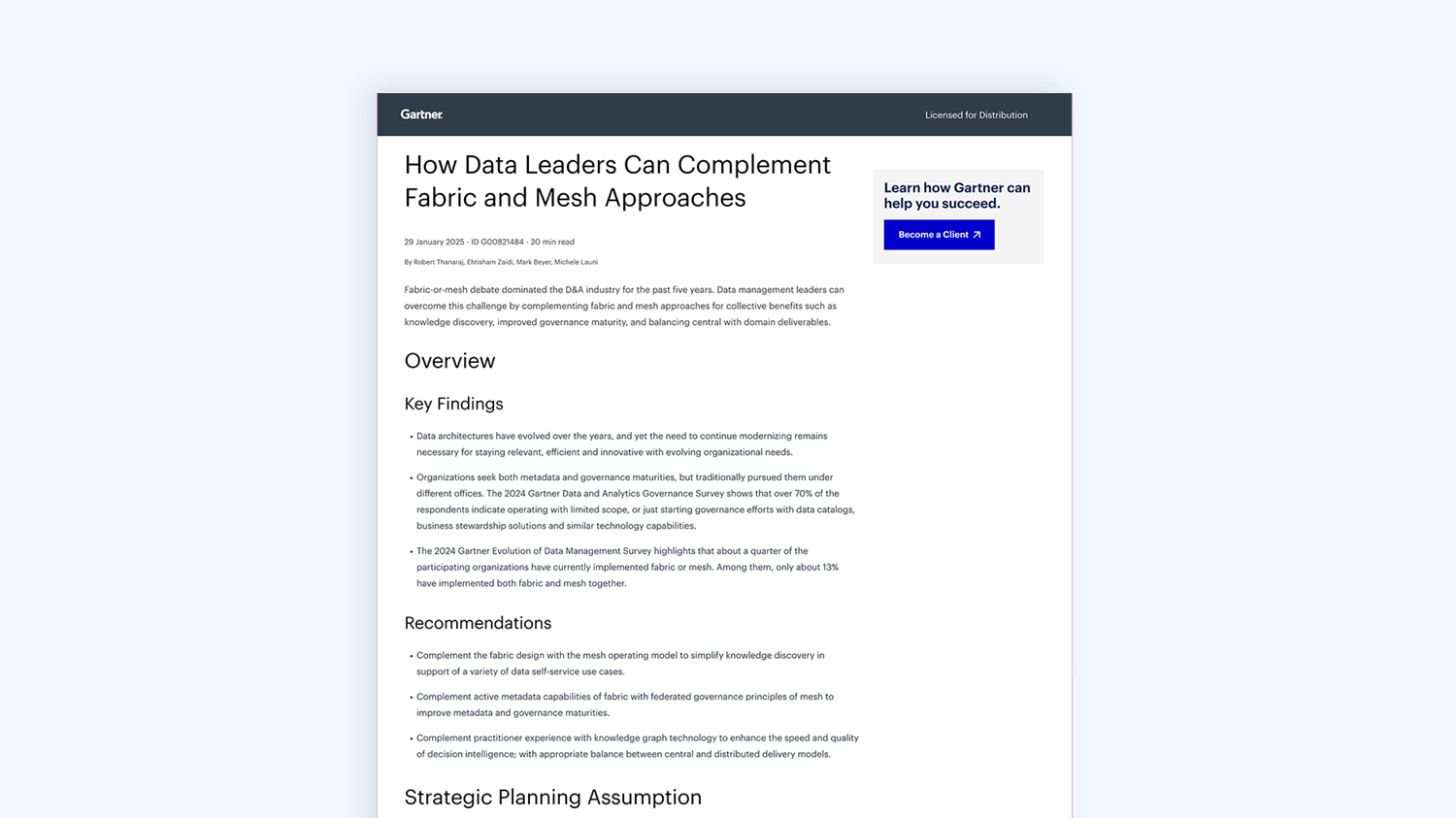Key Challenges in Healthcare Data Management
Challenge 1: Fragmented Business and Operational Data
Healthcare organizations struggle with data silos across financial systems, quality reporting, operational databases, and patient satisfaction platforms. Business analysts, finance teams, and operations managers need comprehensive views but must access multiple systems manually, creating delays in critical business decisions.
Challenge 2: Complex HIPAA Compliance and Governance
Healthcare regulations require comprehensive data governance across all patient-related information while maintaining audit trails and access controls. Managing HIPAA compliance across dozens of data sources while enabling business analytics creates significant administrative overhead and regulatory risk.
Challenge 3: Hybrid Cloud and Legacy System Integration
Healthcare organizations maintain significant data infrastructure on-premises due to regulatory requirements and legacy system investments, while simultaneously adopting cloud-based analytics and modern operational platforms. This hybrid architecture creates integration challenges between legacy financial systems and modern business intelligence platforms.
Challenge 4: Real-Time Operational Decision Making
Modern healthcare operations require immediate access to financial, quality, and operational data for bed management, staffing decisions, and resource allocation. Traditional data integration creates delays that impact operational efficiency and patient care coordination.
Challenge 5: Research Data Access and Clinical Trial Efficiency
Life sciences companies and healthcare research teams need unified access to clinical trial data, real-world evidence, and operational research metrics. Research data exists across multiple systems with complex governance requirements that slow drug development and clinical research.
Challenge 6: Business Analyst Productivity and Self-Service Access
Healthcare business analysts spend 60-80% of their time finding and preparing data rather than generating insights. Finance, operations, and quality teams depend on IT for data access, creating bottlenecks that slow critical business decisions and operational improvements.
How Data Fabric Transforms Healthcare Operations
Instant Access to Healthcare Data
Query data across financial systems, quality databases, operational platforms, and research repositories in real-time without migration or complex ETL processes. Get immediate answers to business questions like “What’s our average length of stay by service line this quarter?” directly from your existing systems.
HIPAA-Ready Governance & Compliance
Built-in governance ensures HIPAA compliance across all data sources simultaneously. Automated audit trails and access controls reduce compliance preparation time by up to 75% while maintaining strict adherence to healthcare privacy regulations and reporting requirements.
Conversational Data Access
Enable healthcare professionals to ask natural language questions like “Show me quality metrics for cardiac procedures with readmission rates above benchmark” and get immediate, governed insights without technical training or SQL knowledge.
Zero-Copy Hybrid Architecture
Access data where it lives across cloud, on-premises, and hybrid environments without costly data movement or storage duplication. Seamlessly stitch together legacy healthcare systems with modern analytics platforms while maintaining data sovereignty and HIPAA compliance.
Enterprise-Scale Performance for Healthcare Workloads
Modern data fabric platforms are designed to handle the large datasets common in healthcare organizations through intelligent query optimization and distributed processing. Purpose-built for enterprise healthcare environments, instant data fabric delivers optimized performance even when querying millions of patient records and transactions across multiple business systems.

Healthcare Data Fabric Use Cases
Use Case 1: Clinical Research and Trial Acceleration
Challenge: Research teams and life sciences companies need faster access to clinical trial data, real-world evidence, and research metrics but face complex data integration challenges across research databases and operational systems.
Solution: Unified access to research data with natural language queries for trial enrollment, outcome analysis, and regulatory reporting across distributed research platforms.
Results: 40% faster clinical trial enrollment, 30% reduction in research data preparation time, accelerated drug development timelines.
Use Case 2: Patient 360 and Care Coordination
Challenge: Care teams and business analysts need comprehensive patient views across clinical, financial, and operational systems to improve care coordination and business decision-making, but data exists in separate platforms.
Solution: Unified patient profiles combining available clinical data, financial records, and operational metrics with business intelligence for care management and revenue optimization.
Results: 25% improvement in care coordination, 35% faster patient onboarding, enhanced revenue capture and patient satisfaction.
Use Case 3: Accelerated Financial and Revenue Cycle Analytics
Challenge: Finance teams need comprehensive revenue cycle data across billing, collections, and payer systems but must access multiple systems manually, creating delays in financial reporting and cash flow analysis.
Solution: Instant access to unified financial data across all systems with conversational queries like “Show me denials by payer with average resolution time and revenue impact.”
Results: 50% faster financial reporting, 30% improvement in revenue cycle efficiency, enhanced cash flow management.
Use Case 4: Real-Time Operational Efficiency and Bed Management
Challenge: Operations teams need immediate access to bed capacity, staffing levels, and patient flow data but lack unified views across operational systems for effective resource management.
Solution: Real-time federated queries across operational systems with automated dashboards for capacity management and resource allocation.
Results: 25% improvement in bed utilization, 40% faster discharge processing, enhanced operational efficiency.
Use Case 5: Quality Metrics and Patient Outcome Reporting
Challenge: Quality teams spend weeks manually aggregating data from multiple systems for regulatory reporting, patient safety metrics, and outcome analysis.
Solution: Automated quality reporting with unified access to clinical, operational, and financial data for comprehensive outcome analysis.
Results: 75% reduction in quality reporting preparation time, 50% improvement in metric accuracy, enhanced patient safety monitoring.
Healthcare Data Fabric Vendor Landscape
Traditional Enterprise Platforms
IBM Cloud Pak for Data, Microsoft Fabric, Informatica
- Comprehensive capabilities but require 6-18 months implementation
- Complex deployment requiring specialized healthcare consulting teams
- High infrastructure and ongoing operational costs
Legacy Healthcare Analytics Solutions
Epic Clarity, Cerner PowerChart, Traditional BI Platforms
- Limited to single-vendor ecosystems
- Complex customization and maintenance requirements
- Restricted data access and limited self-service capabilities
Instant Data Fabric Platforms
Promethium
- Conversational data access through natural language queries
- Zero-copy architecture with deployment in days, not months
- 360° context engine for trusted insights without consultant dependencies
- Empowers existing healthcare business teams with self-service analytics
For a complete vendor analysis including detailed Palantir comparison, see our Data Fabric Vendor Comparison 2025.
Implementation Approach for Healthcare
Healthcare Data Fabric Implementation Comparison
| Implementation Factor | Traditional Platforms | Legacy Healthcare Solutions | Instant Data Fabric (Promethium) |
| Deployment Time | 6-18 months | 12-24 months | Days to weeks |
| Implementation Cost | $3-10M+ infrastructure | $5-15M+ customization | Transparent subscription |
| Team Requirements | Specialized consultants | Healthcare IT specialists | Existing business teams |
| Ongoing Dependencies | High IT maintenance | Vendor-specific support | Self-service platform |
| User Training | Extensive technical training | System-specific training | Natural language interface |
| System Integration | Custom development | Limited integration | Flexible healthcare connectors |
| HIPAA Compliance | Manual configuration | Built-in but limited | Automated governance |
| Total Cost of Ownership | High + hidden costs | Very high + maintenance | Predictable subscription model |
Timeline Comparison:
Traditional/Legacy Approach:
- Months 1-6: Infrastructure setup, system integration across financial and operational systems
- Months 7-12: Data modeling, compliance implementation, custom development
- Months 13-18: User training, workflow integration, change management
- Month 18+: Production use and value realization
Instant Data Fabric Timeline:
- Week 1: Platform setup and connection to financial, quality, and operational systems
- Week 2: User onboarding for business analysts, finance, and operations teams
- Week 3+: Full production use with immediate productivity gains
Healthcare Success Metrics
Healthcare organizations implementing data fabrics typically see:
60%
improvement in analyst productivity and insight generation
50%
faster financial and operational reporting
60%
reduction in quality metrics preparation time
40%
improvement in operational efficiency
30%
faster research data analysis and clinical trial processes

Compliance & Security for Healthcare
HIPAA and Healthcare Regulations
- Built-in HIPAA compliance frameworks with automated privacy controls
- Automated audit trails for healthcare regulatory examinations
- Real-time policy enforcement across all healthcare data sources
- Support for quality reporting and patient safety requirements
Healthcare Data Governance
- Role-based access controls aligned with healthcare organizational structure
- Data lineage tracking for regulatory and quality reporting
- Centralized policy management across distributed healthcare systems
- Protection of sensitive patient and financial information
Getting Started with Healthcare Data Fabric
Evaluate Your Current State
- Audit existing healthcare business systems and integration complexity
- Assess regulatory reporting burden and compliance gaps
- Identify high-value use cases like financial reporting or operational analytics
Pilot Implementation
- Start with financial or quality data integration across 2-3 core systems
- Enable self-service access for business analysts and finance teams
- Measure time-to-insight improvements and analyst productivity gains
Scale Across Healthcare Operations
- Expand to operational, quality, and research systems
- Enable enterprise-wide self-service data access
- Integrate with external data sources for enhanced analytics
Frequently Asked Questions
Data fabric enables healthcare analysts to access comprehensive financial, operational, and quality data from a single interface using natural language queries. Instead of manually checking multiple systems, teams can ask questions like “Show me revenue by service line with quality metrics and patient satisfaction scores” and get immediate, governed results.
Modern data fabric platforms provide comprehensive HIPAA governance capabilities including automated audit trails, data lineage tracking, and centralized access controls across all data sources. This unified approach to data governance significantly reduces the time and effort required for regulatory reporting and compliance preparation while ensuring strict healthcare privacy protections.
Yes, data fabric platforms are designed to connect with healthcare business systems through standard APIs and connectors, enabling immediate value without replacing existing financial, operational, or quality reporting investments. Integration approaches are designed to work around the complexity of clinical systems.
Data fabric enables research teams to access unified clinical trial data, real-world evidence, and operational research metrics through conversational queries. This accelerates clinical trial enrollment, reduces research data preparation time, and speeds drug development timelines by providing immediate access to research-relevant data.
Instant data fabric platforms can be deployed and delivering value within days to weeks, compared to 6-18 months for traditional healthcare analytics platforms. Business teams can start seeing productivity improvements in financial reporting, operational analytics, and quality metrics immediately after deployment.
Learn More With Related Content & Resources
- Read the full data fabric explainer
- Compare data fabric vs data mesh
- Compare data fabric vs data virtualization
- Explore the full insights hubs


